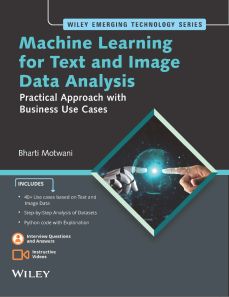Machine Learning for Text and Image Data Analysis
ISBN: 9789354643606
828 pages
Publication Year: 2023
For more information write to us at: acadmktg@wiley.com

Description
Machine Learning for Text and Image Data Analysis: Practical Approach with Business Use Cases enables readers gain sufficient knowledge and experience to perform analysis for text and image data using different machine learning techniques available in Python. The objective is to explain the concepts and to simultaneously develop in readers an understanding of its application with case-based methodology. The book attempts to provide more meaningful and easier learning experience, it has been written with more interesting and relevant real-life examples.
Preface
About the Author
Section 1 Introduction to Text and Image Data Analysis
Chapter 1 Basics of Python
1.1 Introduction to Python
1.2 Programming in Python
1.3 Data Structures in Python
1.4 Basic Functions for Text Data
1.5 Data Management
1.6 Data Visualization
Chapter 2 Text and Image Data Pre-Processing
2.1 Text Data Pre-Processing Using nltk Library
2.2 Text Pre-Processing Using “spacy” Library
2.3 Image Data Pre-Processing
Section 2 Unsupervised Machine Learning for Text and Image Data Analysis
Chapter 3 Sentiment Analysis and Topic Modeling
3.1 Introduction
3.2 Sentiment Analysis Using Lexicon-Based Approach
3.3 Topic Modeling Using “Gensim” Library
Chapter 4 Content-Based Recommendation System
4.1 Introduction
4.2 Content-Based Recommendation System for Text Data
4.3 Content-Based Recommendation System for Image Data
Chapter 5 Collaborative Filtering Recommendation System
5.1 Introduction
5.2 Collaborative Filtering Recommendation System for Text Data
5.3 Collaborative Filtering Recommendation System for Image Data
Chapter 6 Association Rule Mining
6.1 Introduction
6.2 Association Rule Mining for Text Data
6.3 Image Data analysis
Chapter 7 Cluster Analysis
7.1 Introduction
7.2 Cluster Analysis for Text Data
7.3 Cluster Analysis for Image Data
Section 3 Supervised Machine Learning for Text and Image Data Analysis
Chapter 8 Supervised Machine Learning Problems
8.1 Introduction
8.2 Supervised Machine Learning Algorithms for Text Data Analysis
8.3 Supervised Machine Learning Algorithms for Image Data Analysis
Chapter 9 Supervised Machine Learning Regression Techniques
9.1 Introduction
9.2 Supervised Machine Learning Regression Algorithms for Text Data Analysis
9.3 Supervised Machine Learning Regression Algorithms for Image Data Analysis
Chapter 10 Supervised Machine Learning Classification Techniques
10.1 Introduction
10.2 Supervised Machine Learning Classification Algorithms for Text Data Analysis
10.3 Supervised Machine Learning Classification Algorithms for Image Data Analysis
Section 4 Deep Learning for Text and Image Data Analysis
Chapter 11 Neural Network Models (Deep Learning)
11.1 Introduction
11.2 Neural Network Models for Text Data Analysis
11.3 Neural Network Models for Image Data Analysis
Chapter 12 Transfer Learning for Text Data Analysis
12.1 Introduction
12.2 Recommendation System Using Transfer Learning for Text Data
12.3 Cluster Analysis Using Transfer Learning for Text Data
12.4 Supervised Machine Learning Using Transfer Learning for Text Data Analysis
12.5 User-Defined Trained Deep Learning Model
12.6 Text Data Extraction Using Transfer Learning for Text Data
Chapter 13 Transfer Learning for Image Data Analysis
13.1 Introduction
13.2 Recommendation System Using Transfer Learning for Image Data
13.3 Cluster Analysis Using Transfer Learning for Image Data
13.4 Supervised Machine Learning Using Transfer Learning for Image Data Analysis
13.5 Facial Recognition Using Transfer Learning for Image Data Analysis
13.6 Gender and Age Determination Using Transfer Learning for Image Data Analysis
13.7 Creating, Saving, and Loading User-Defined Model for Feature Extraction
Chapter 14 Chatbots with Rasa
14.1 Understanding Rasa Environment and Executing Default Chatbot
14.2 Basic Chatbot
14.3 Chatbot with Entities and Actions
14.4 Chatbot with Slots
14.5 Creating Chatbot with Database
14.6 Chatbot with Forms
14.7 Creating Effective Chatbot
Chapter 15 The Road Ahead
15.1 Reinforcement Learning
15.2 Federated Learning
15.3 Graph Neural Networks
15.4 Generative Adversial Network
Answer Keys to the Multiple-Choice Questions
Possible Interview Questions
Index

